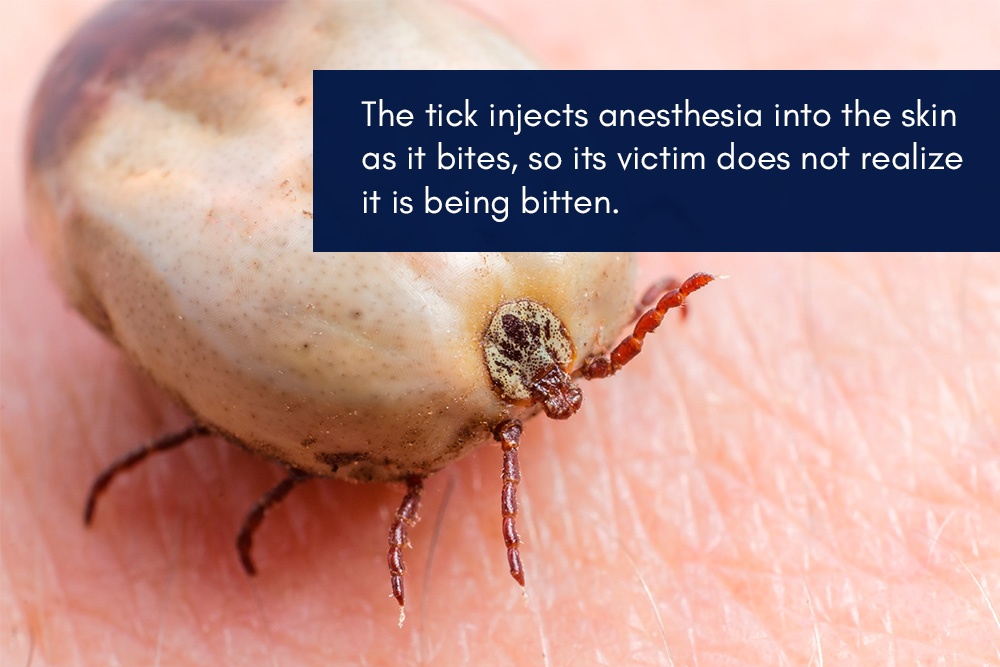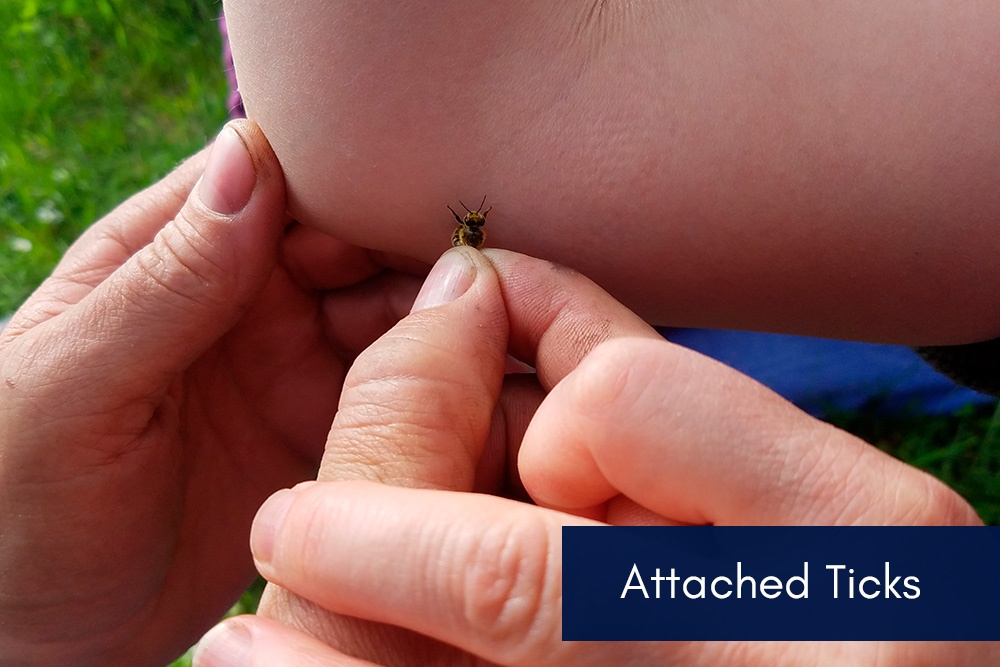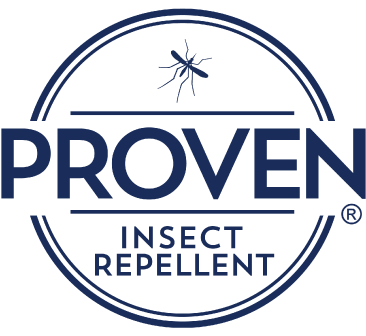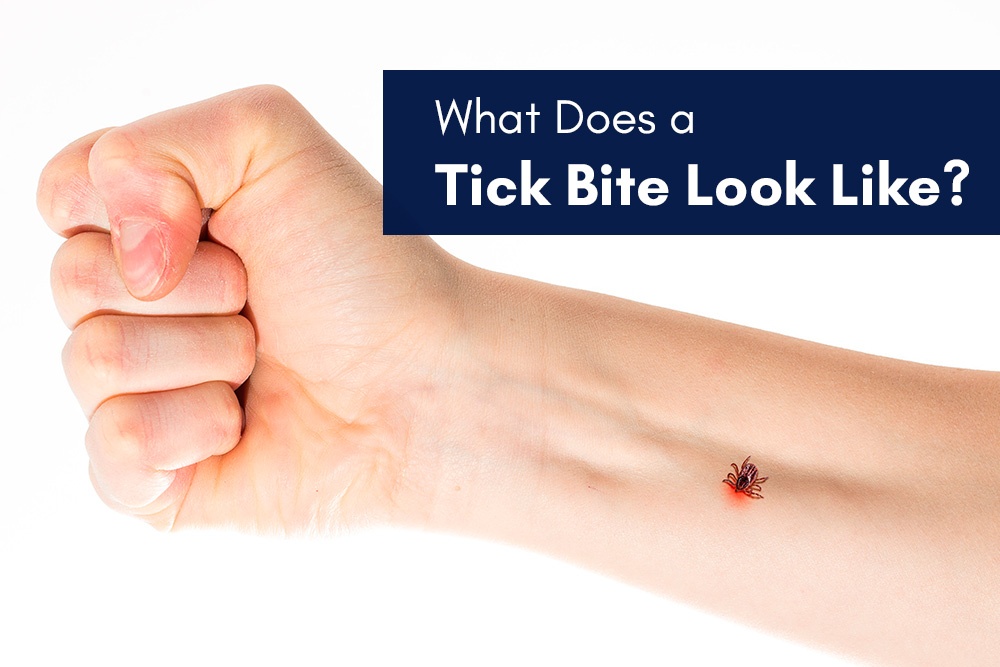Members of the arachnid family, ticks are tiny eight-legged insects related to spiders. Their bites are typically painless but can result in irritation. Adult ticks range in size from as small as the head of a pin to as big as a small watermelon seed and are colored in shades of brown and black. Ticks feed on warm-blooded creatures and burrow their entire head under their victim’s skin. The tick’s body swells as it feeds, growing to the size of a blueberry. After it has fed, it will often take on a greenish-blue color. After feeding, the tick will detach itself from its host and digest its meal.

The tick injects anesthesia into the skin as it bites, so its victim does not realize it is being bitten. Professor Jonathan Day at the University of Florida’s Department of Entomology states that most blood-feeding arthropods and insects introduce proteins into the wound to prevent blood clotting and disrupting their feeding. These proteins trigger the immune system’s reaction in the host, which results in skin irritations like redness, swelling, and itching. However, ticks also have an immunosuppressant in their saliva that suppresses that reaction.
If not disturbed, ticks can stay attached for between several hours and a few days. Because you can’t feel a tick’s bite, it is important to keep a watchful eye out for ticks that may have gotten on you and be on the lookout for indications that you may have been bitten. Tick bites can be detected by looking for a feeding tick embedded in your skin or identifying a bite site after the tick has dropped off. It must be noted the risk of all of this can be greatly reduced by simply using some tick protection when in tick habitats, and environmentally friendly bug spray is available for the environmentally conscious crowd.
Picking Up Ticks

While they are found in a wide variety of habitats across the U.S., from the deep woods to manicured schoolyards, there are a few places where ticks are the most prevalent. These include:
• Tall grass and weeds
• Shrubs and brush
• Leaf litter
A tick attaches itself to a host by laying in wait in tall grass or brush until an unsuspecting animal passes by. Ticks hang from vegetation by their hind legs, roughly 24 to 30 inches off the ground, using a behavior called “questing.” When a mammal or bird brushes against the tick, it grabs onto the animal with its front legs. A good tick repellent or insect repellent lotion will deter ticks from attaching themselves to you. Once a tick has hitched a ride on a host, its natural instinct is to climb upward until it finds a suitable spot to feed. Ticks can also be picked up when clearing leaves and downed tree branches. However, ticks do not live in trees and can’t jump.
Preferred Attachment Sites
As ticks do not like dry environments, attachment sites are often warm moist areas such as the groin or armpit. However, ticks will attach themselves anywhere on the body including:
• Arms
• Back
• Buttocks
• Head
• Inside and outside of ears
• Legs
• Naval
• Neck
Checking for Ticks and Bites
Always check yourself and your pets thoroughly from head to toe after being outside anywhere ticks are known to inhabit, paying particular attention to their preferred attachment sites. Take a shower and wash all areas, feeling for attached ticks with your fingers. Additionally, running your clothes through the drier on high for 15 minutes will kill any ticks hiding in your clothing.
Attached Ticks

Finding a tick on your skin can be challenging unless it is in a highly conspicuous place, like a forearm. While adults may be large enough to spot, tick nymphs may go unnoticed as these are only about the size of a poppy seed. If you find one attached, a tick can be removed with special tweezers or other devices like the “tick twister.” Note that standard tweezers are ineffective at removing ticks as the insects have tiny hairs on their heads, making tweezing challenging. This can result in breaking the head off and leaving it lodged under your skin, requiring surgical removal.
Recognizing Tick Bites
Tick bites will sometimes present with a small puncture mark where it bit your skin, and a small dry scab may have formed around the wound. Even though tick bites typically don’t begin itching immediately, the bite can cause a red and/or itchy lesion after the tick has dropped off. The size, state, and appearance of this lesion can vary based on the type of tick, how long it was attached, if it was infected with a pathogen, and the individual reaction. If the tick was not infected, the bite may resemble a small mosquito or spider bite and will usually fade away fairly quickly with no treatment. An allergic reaction may develop in rare cases that causes increased redness, swelling, itchiness, rashes, or other symptoms. However, if the tick carries a blood-borne disease, serious complications can arise.
It is essential to understand that a tick must be attached for at least 24 hours and up to 36 hours before it has had enough time to transmit the bacteria in its stomach into your blood to cause an infection. While some symptoms indicate the presence of a bacteriological disease, like Lyme disease or Rocky Mountain spotted fever, many times, infection is entirely asymptomatic. Following are the two main types of rashes that commonly present with tick-borne illness:
1) Bullseye Rash
Scientifically known as erythema migrans, a signature “bullseye” rash is often present with Lyme disease and usually appears from three to 30 days after infection. This presents a distinct pattern of red circles surrounding the tick bite, ranging from five to 70 cm in diameter. The rash will spread as the disease advances. However, the bullseye rash only presents in approximately 75 percent of cases.
2) Red Blotching
Rocky Mountain Spotted Fever (RMSF) is another tick-borne illness that presents with a rash. RMSF is characterized by small red blotches ranging from one to 5 mm. These blotches typically begin to appear adjacent to the bite site between two and four days post-infection and gradually spread out.
Seeking Medical Help
If you notice either of these types of rashes or experience flu-like symptoms that do not lessen after a few days and believe a tick may have bitten you, you should seek medical attention. Tick-borne bacterial diseases are easily treatable with antibiotics.
Preventing Infection
Using an effective tick repellent will reduce the chances of being bitten. In addition to wearing tick spray, long pants tucked into your socks and long sleeves, when warranted, will give the little blood suckers less skin to attach themselves to.
Not all ticks carry disease, and infections are readily treatable, so being bitten is not a cause for overreaction. However, it is still advisable to protect yourself however possible, and many effective insect repellents are available. ProvenⓇ makes a full line of picaridin-based insect repellent sprays and lotions suitable for the entire family. ProvenⓇ is an excellent alternative to DEET-based repellents due to its low acute toxicity and high, long-lasting efficacy. ProvenⓇ odorless insect repellent lotion that protects for up to 14 hours. ProvenⓇ products can be found online at provenrepellent.com, Amazon, and in-store at Meijer, Tractor Supply Company, Target and ACE Hardware.



Recent Comments